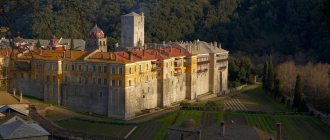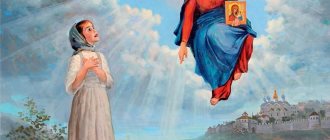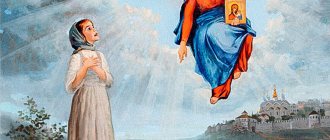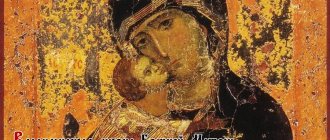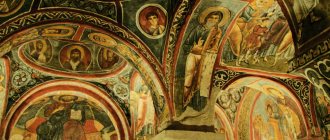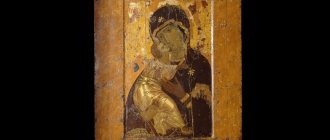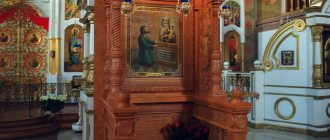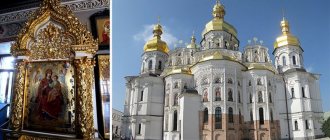The image of the Mother of God is one of the most revered in Christianity. In particular, in Orthodoxy she is placed above angels and saints. The Queen of Heaven is the most perfect woman since the creation of the world.
It is believed that the Mother of God herself chose Rus' and took it under her protection. She protects our land and everyone living on it in every possible way. And it is not surprising that from time immemorial in Rus' there were many temples dedicated to the Ever-Virgin, and her icons often became miraculous.
This publication is dedicated to one of the most revered images of the Queen of Heaven - the Tikhvin Icon of the Mother of God.
The history of the discovery of the Tikhvin Icon of the Mother of God
Traditions attribute the creation of this icon to Evangelist Luke. He, inspired by the Lord, painted the image of the Ever-Virgin from life during her lifetime. The Queen of Heaven fell in love with this masterpiece, blessed it and endowed it with the power to work miracles.
This icon painting type was called Hodegetria, translated from Greek as “Guide”. As legends say, the very first icon of this type (the same one from Luke) was transported to Constantinople around the 5th century. According to some reports, the evangelist icon painter gave this image to Theophilus of Antioch, his student and follower. Thus, the icon delighted parishioners in Jerusalem for several centuries and only then came to Byzantium.
The icon was kept either in the Blachernae Church or in the Odigon Monastery - the data is contradictory. But there is information that she died during the conquest of Constantinople by the Turks - she was simply chopped up with sabers to take away the gold salary and precious stones.
Most likely, the Tikhvin icon known to us was painted much later. Some researchers attribute it to the 8th century, that is, the period of spiritual rule of Patriarch Henry, an ardent opponent of the iconoclasm that swept Byzantium during this period. Allegedly, the bishop himself made a copy of the Lydda Icon of the Mother of God, which is considered not made by hands, that is, created by the will of God without human participation.
Supporters of the iconoclasm movement considered the worship of images a sign of idolatry, which is contrary to the spirit of true Christianity. As a result of the actions of fanatics, thousands of priceless icons, sculptures, frescoes, altars and other religious symbols, representing outstanding works of art of that time, were lost.
Icon of the Mother of God located in Tikhvin
It is with iconoclasm, as well as the pride and numerous sins of the Byzantines, that the appearance of the Mother of God in Tikhvin is connected. It is believed that the miraculous image became angry with the inhabitants of Constantinople and was transported by air to the Russian town of Tikhvin, in the Novgorod lands. This was in 1383.
Numerous witnesses indicated that the icon carried by the angels was seen in Rus' exactly seven times. The Mother of God herself chose a place on the banks of the Tikhvinka River, where a temple was subsequently built especially for her, and even later a monastery was founded.
Despite all the efforts of the princes and representatives of the clergy, Rus' remained predominantly pagan. It is believed that the icon of Our Lady of Tikhvin chose these regions because they did not yet believe too much in the true God.
Tikhvin quickly became a center of pilgrimage and worship of the divine relic. Both simple pilgrims professing the new faith and nobles, including princes, came to the icon.
The first church of the Mother of God in Tikhvin was wooden. It soon burned down, but the wonderful icon was not damaged and received a new home - a luxurious stone church - the Tikhvin Assumption Cathedral, which still stands today.
Grand Duke Vasily III contributed to strengthening the veneration of the icon. He came to pray to the Mother of God and his wife, so that she would send down an heir to the princely couple. Two years later, the couple had a son, Ivan, who later became autocrat Ivan the Terrible. Since then, this icon has been called Tikhvinskaya.
For many centuries, the icon remained in the Assumption Church at the monastery. However, the events of 1917 changed everything: religious persecution began in Russia, priests were shot, churches and monasteries were desecrated and destroyed, icons were destroyed.
Tikhvin Mother of God Assumption Monastery
The Tikhvin Monastery was closed, but the wonderful icon again escaped a sad fate: it was transferred to the local history museum. It was removed from the museum's storerooms during the German occupation, transported to Pskov, then to Lithuania, Germany...
In short, in the middle of the last century, the image of Our Lady of Tikhvin miraculously ended up in the USA, and more specifically, in an Orthodox church in Chicago.
The rector of the temple directly stated in his will: the icon should return to its homeland, but only when the temple and monastery are restored and consecrated. This happened in 1995, and nine years later Our Lady of Tikhvin returned to her place of prayer.
The icon was taken to Tikhvin through Riga, Moscow and St. Petersburg, and hundreds of thousands of people paid homage to it along the way. The Mother of God was delivered to Tikhvin by a special train, and was carried to the temple with all honors, along a road strewn with fresh flowers.
Iconography
As mentioned above, the Tikhvin Mother of God belongs to the Hodegetria type, that is, “Showing the way” or “Guide”. This is a waist-length icon (the Ever-Virgin is depicted from the waist up). She is dressed in scarlet robes and a maforium with three stars symbolizing purity.
Jesus, dressed in a golden robe, sits on the lap of his royal mother. With one hand he blesses those praying, in the other he clutches a scroll with the Gospel. It is clear that Mother and Son are communicating, but they also invite those praying to the conversation.
The type of Hodegetria is close to Ileusa (“Tenderness”), that is, the iconography inherent, for example, in the Vladimir Mother of God - the same pair, similar vestments and the heel of the Savior turned towards the viewer. However, in Hodegetria the center of the composition is Christ, and in the form of a youth, and the lyricism in the images is smaller - mother and son are depicted at a distance, and not clinging to each other.
Second prayer
We thank Thee, O Most Blessed and Most Pure, Most Blessed Virgin, Lady, Mother of Christ our God, for all Thy good deeds, which Thou hast shown to the human race, especially to us, the people of Russia named after Christ, about whom the most angelic tongue will be pleased with praise. We thank You, as even now You have surprised Your ineffable mercy on us, Your unworthy servants, with the supernatural self-coming of Your Most Pure Icon, and with it You have enlightened the entire Russian country.
Likewise, we, sinners, worshiping with fear and joy, cry out to Thee: O Most Holy Virgin, Queen and Mother of God, save and have mercy on Thy people, and grant them victory over all their enemies, and preserve the reigning cities, and all Christian cities and countries, and deliver this holy temple from every slander of the enemy, and grant everything for the benefit of all, who now come with faith and pray to Your servant, and who worship Your Most Holy Image, for blessed are You with the Son and God born of You, now and ever and unto the ages of ages . Amen.
The meaning of the image in Orthodoxy
The significance of the image of the Mother of God in Orthodox Christianity is incredibly enormous: as mentioned above, the Ever-Virgin is the intercessor of Rus'. In Russia there are more than half a thousand churches consecrated in the name of Mary, and the number of her miraculous icons is in the hundreds.
In the Orthodox church calendar there are more than a dozen feasts of the Mother of God, and most of them are immovable, that is, with a fixed date. In addition, there are many holidays dedicated to especially revered images of the Mother of God.
Guardian of the Russian Land
One of the Christian shrines of Russia is the Tikhvin Icon of the Mother of God. This image became famous for a variety of miracles. In particular, by phenomena (appearances of icons in various places). Signs (miraculous events that serve as evidence of God's special presence). Healing the sick. But the icon gained special popular love during the defense of Russia from enemy attacks. She is the Defender, the Guardian of our Motherland.
Hieromonk Philadelph Bogolyubov (1915-1992) wrote:
“As before, the miraculous icons of the Mother of God protect the Russian land. For example, the Tikhvin Icon protects and blesses the northern borders.”
Tikhvin Icon of the Mother of God
How does the Tikhvin Icon of the Mother of God help?
The miraculous icon helps those praying in many areas of life. You can ask her for almost anything:
- Help in treating addictions. More than one miracle of salvation from addiction and mental illness has been described. In particular, there is a known case when sincere prayer helped save a young man who had embarked on the destructive path of drug use. The guy ended up in intensive care due to an overdose, the grief-stricken parents sincerely prayed to Our Lady of Tikhvin, the son woke up and never returned to bad habits.
- Getting rid of ailments. A family lived a hundred kilometers from Chicago. The daughter suffered from an illness considered incurable. However, the mother’s fervent prayer in front of the icon (she was still in the USA at that time) created a miracle: her daughter recovered!
- Conception and successful delivery. The Tikhvin icon is often called the Child-Giver. Parishioner Elena could not get pregnant for a long time. When the icon was taken to Tikhvin, Elena went to venerate the miraculous image. Soon the doctors said that the women’s ailments had passed, the desired pregnancy had occurred, and the healthy newborn baby was named Maria.
- Health and return of children to the right path. Our Lady of Tikhvin acts as a protector of children and family relationships. They pray to her that babies will be calm and develop normally, schoolchildren will study well and obey their elders, teenagers will not get involved with bad companies and find their place in life.
- Consolation and making the right decision. Sincere prayer to Our Lady of Tikhvin helps not to fall into the sin of despondency during life’s troubles and the loss of loved ones, to find the joy of life and not to succumb to temptation, to choose the right decision in the most difficult situation. Mary protects from the machinations of haters and the vices inherent in any person.
- Happiness in your personal life, harmony in the family and improved relationships with relatives. It has been noticed: if there is an icon of the Tikhvin Mother of God on the family altar, quarrels between household members arise much less frequently. Marital love and mutual respect are revived, children become more diligent and obedient. And single people can pray to find a couple.
As the defender of Holy Rus', Our Lady of Tikhvin often defended our lands from invaders. It is believed that it marked the beginning of a truce in the Russian-Swedish war of the 17th century. Terrible visions appeared to the Swedes, and they fled from the monastery in fear.
Where is the shrine located
As mentioned above, the original icon is now in Tikhvin (Leningrad Region), in the Church of the Mother of God Assumption Monastery. Tens of thousands of pilgrims from Russia, near and far abroad come to the shrine every year.
In addition to the main prototype image, there are hundreds of lists in Russia, dozens of which are revered as miraculous. In Moscow alone there are at least a dozen images of the Tikhvin Mother of God with confirmed miraculous properties.
Source and chapel of Our Lady of Tikhvin near Ilyinsky
Near Moscow, not far from Ilyinsky, there is a small chapel and a holy spring dedicated to the Tikhvin Mother of God. Despite the fact that the holy place is located far from crowded places and well-trodden roads, pilgrims constantly flock to it. This is a truly fabulous place where you can bow to the Ever-Virgin, ask for protection, quench your sorrows, relax in body and spirit, and strengthen your faith.
According to legend, an icon of the Tikhvin Mother of God was discovered at this place. Even before the revolution, it was found by a local peasant who was digging a well. As soon as he removed the image from the ground, a wonderful spring began to flow from under it.
Iconography style of the Evangelist Luke
The image is determined by a strictly regulated system of writing and is classified as the type of face of the Mother of God-Hodegetria, which almost always depicts the spiritual dialogue of the Mother of God and the little Christ. The Son of God clutches a scroll in one hand on which sacred messages are engraved, and with the other hand he blesses those around him.
The baby's legs are bent and he holds his right foot slightly higher than his left. The Virgin Mary bows her head in prayer. This fact is the difference between this icon and the Smolensk Mother of God. The style of creation is considered the most orthodox and triumphant.
Elements of the face can be clearly seen in the photo of the Tikhvin Icon of the Mother of God.
How to pray to an image correctly
A home iconostasis is usually installed on the eastern wall of the home, away from household appliances, paintings and books of worldly content.
The image of the Mother of God is usually placed to the right of the icon of her divine offspring, but if there are no other icons, it can be placed separately. The main thing is that there is enough free space in front of the image for kneeling and prayer.
Texts of prayers
You need to pray to the Mother of God with extreme concentration and seriousness. It is advisable to wear clean, neat clothes, and for women to tie a scarf as a sign of humility and respect in front of the person. If this is not possible, you can pray in ordinary clothes that you wear at home.
It is advisable to light a church candle or lamp and first read the “Our Father”.
Prayer for intercession and quenching sorrows (for all occasions)
O Most Holy Virgin, Mother of the Lord of the highest powers, Queen of Heaven and earth, our city and country, Almighty Intercessor. Accept this singing of praise and gratitude from us, unworthy Thy servants, and lift up our prayers to the throne of God Thy Son, that He may be merciful to our iniquities and add His goodness to those who honor Thy all-honorable name and with faith and love who worship Thy miraculous image. You are not worthy of being pardoned by Him, unless you have propitiated Him for us, Lady, since everything is possible for You from Him. For this reason, we resort to You, as to our undoubted and immediate Intercessor: hear us praying to You, cover us with Your all-powerful protection and ask God Your Son to be our shepherd, zeal and vigil for souls, a city ruler for wisdom and strength, judges for truth and impartiality, a mentor for reason and humility, love and harmony for the spouse, obedience for the child, patience for the offended, fear of God for those who are offended, complacency for those who grieve, abstinence for those who rejoice, but for us all the spirit of reason and piety, the spirit of mercy and meekness, the spirit of purity and truth. To her, Most Holy Lady, have mercy on Thy weak people, gather the scattered, guide those who have gone astray, support old age, raise young children to be wise, and look upon all of us with the gaze of Thy merciful intercession, raise us up from the depths of sin and enlighten our heartfelt eyes to to the sight of salvation, be merciful to us here and there, in the land of earthly arrival and at the Last Judgment of Your Son; Having ceased in faith and repentance from this life, our fathers and brethren will live with the angels and all the saints in eternal life. For you are, Lady, the glory of heaven and the hope of earth, You, according to God, are our Hope and Intercessor of all those who flow to You with faith. We therefore pray to You, and to You, as the Almighty Helper, we commit ourselves and each other and our whole life, now and ever and unto ages of ages. Amen.
Prayer for the health and well-being of children
O Most Holy Lady Virgin Theotokos, save and preserve under Your shelter my children (names), all youths, young women and infants, baptized and nameless and carried in their mother’s womb. Cover them with the robe of Your motherhood, keep them in the fear of God and in obedience to their parents, pray to my Lord and Your Son to grant them what is useful for their salvation. I entrust them to Your maternal supervision, for You are the Divine Protection of Your servants. Mother of God, introduce me to the image of Your heavenly motherhood. Heal the mental and physical wounds of my children (names) caused by my sins. I entrust my child entirely to my Lord Jesus Christ and Your, Most Pure, heavenly protection. Amen.
Prayer for the conception of a child and a safe delivery
Oh, All-Merciful, Good and True Protector of ours, Lady Theotokos, who knew the happiness of Motherhood, in which you received the excitement, hopes, anxiety and sorrow of all earthly mothers, do not leave with Your prayers those who fall to Your holy and miraculous icon of Your servant (names) and ask Thy Son and all God's permission for infertility, help and happiness in childbirth, and their reliable protection and protection as a baby. Look, O Most Pure Mother, upon these Thy servants, united in marital union and begging for Thy help, may Thy mercy be upon them, may they be fruitful and may they see their sons' sons to the third and fourth generation and may they live to the desired old age and enter the Kingdom The heavenly Thy Son and our Lord Jesus Christ, to whom all glory, honor and worship is due with the Father and the Holy Spirit forever. Amen.
After prayer, do not forget to bow and make the sign of the cross. If your words came from your soul and heart, the Queen of Heaven will surely hear them!
30.08.21
Veneration of the Blessed Virgin Mary
The Orthodox faith is inextricably linked with the veneration of the Mother of God. The Most Holy Theotokos never leaves the earthly world with Her concern. In Her all the mercy of God is revealed, which is aimed at “seek and save” the human race.
“All the anguish of suffering humanity, all the tenderness for the divine world, which does not dare to pour out before Christ due to religious fear, flows freely and lovingly onto the Mother of God. Ascended into the divine world to the point of indistinguishability from the heavenly God, She, on the other hand, remains, unlike Christ, associated with humanity, a suffering mother and intercessor” (Russian philosopher Georgy Fedotov, 1881-1951).
Therefore, it is not surprising that believers turn to the Blessed Virgin for help in various needs.
The Mother of God’s constant concern for the human race chose icons as a means of constant and grace-filled “communication” between Her and people. Even during her earthly life, the Mother of God prayed and interceded before the Lord for people. But even after the Dormition, She, standing before the Throne of God in heaven, does not leave believers alone. Proof of this is the countless blessings poured out on people through prayers to Her. She directs people to the true path of faith, saves cities and states, provides healing for illnesses, and saves them from hunger and drought. Therefore, the entire Christian world offers Her thanksgiving praises.
“She is a faithful Helper and a warm Prayer Book for us. She herself teaches us to please Her glory and greatness! From the first times, Christians have always entrusted themselves to the protection of the Mother of our Lord Jesus Christ. We will not remain silent about the miracles shown by the Mother of God from Her holy icon. The miraculousness of icons appears for the sake of prayers and firm faith. The prayer of faith is a spiritual force that attracts the power of grace and is itself exalted by the miracles of God’s mercy” (“Earthly Life of the Most Holy Theotokos”, Snessoreva S.I., 1816-1904).
